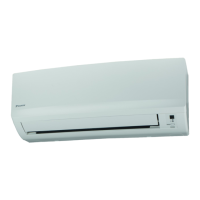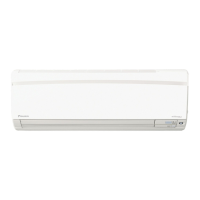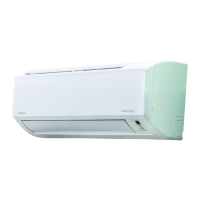Do you have a question about the Daikin FTXN50L and is the answer not in the manual?
General warnings and cautions for repair work, categorized into Warning and Caution.
Specific safety precautions to be observed before and during repair work.
Critical warnings for product installation and post-repair handling to prevent serious injury.
General cautions for product installation and post-repair handling to prevent accidents.
Essential checks to perform after completing repair work for safety and functionality.
Overview of operating modes: Cool, Heat, Fan, Auto, and Dry.
How indoor unit LEDs indicate operational status and errors.
How to retrieve error codes using remote controllers.
Steps to retrieve error codes with BRC52A61 and BRC52B63 remote controllers.
Methods to retrieve the last state error from remote controllers.
Error display and retrieval using the wired controller.
How outdoor unit 7-segment display indicates operational status and errors.
Table detailing error codes and their descriptions for various models.
Troubleshooting steps for indoor PCB abnormalities.
Troubleshooting for freeze protection and high pressure control errors.
Troubleshooting steps for outdoor PCB abnormalities.
Troubleshooting steps for compressor overload conditions.
Troubleshooting steps for compressor lock or start-up abnormalities.
Troubleshooting steps for outdoor fan motor lock issues.
Troubleshooting steps for AC input over current conditions.
Troubleshooting steps for 4-way valve abnormalities.
Troubleshooting steps for discharge pipe overheat conditions.
Troubleshooting steps for heat exchanger overheat conditions.
Troubleshooting steps for compressor sensor system abnormalities.
Troubleshooting steps for compressor position sensor abnormalities.
Troubleshooting steps for AC current sensor abnormalities.
Troubleshooting for various thermistor abnormalities.
Troubleshooting steps for electrical box temperature rise.
Troubleshooting steps for heat sink overheat conditions.
Troubleshooting steps for IPM abnormalities.
Troubleshooting steps for insufficient gas conditions.
Troubleshooting steps for DC voltage out of range errors.
Troubleshooting steps for communication abnormalities.
Troubleshooting steps for installation abnormalities.
General warnings and cautions for repair work, categorized into Warning and Caution.
Specific safety precautions to be observed before and during repair work.
Critical warnings for product installation and post-repair handling to prevent serious injury.
General cautions for product installation and post-repair handling to prevent accidents.
Essential checks to perform after completing repair work for safety and functionality.
Overview of operating modes: Cool, Heat, Fan, Auto, and Dry.
How indoor unit LEDs indicate operational status and errors.
How to retrieve error codes using remote controllers.
Steps to retrieve error codes with BRC52A61 and BRC52B63 remote controllers.
Methods to retrieve the last state error from remote controllers.
Error display and retrieval using the wired controller.
How outdoor unit 7-segment display indicates operational status and errors.
Table detailing error codes and their descriptions for various models.
Troubleshooting steps for indoor PCB abnormalities.
Troubleshooting for freeze protection and high pressure control errors.
Troubleshooting steps for outdoor PCB abnormalities.
Troubleshooting steps for compressor overload conditions.
Troubleshooting steps for compressor lock or start-up abnormalities.
Troubleshooting steps for outdoor fan motor lock issues.
Troubleshooting steps for AC input over current conditions.
Troubleshooting steps for 4-way valve abnormalities.
Troubleshooting steps for discharge pipe overheat conditions.
Troubleshooting steps for heat exchanger overheat conditions.
Troubleshooting steps for compressor sensor system abnormalities.
Troubleshooting steps for compressor position sensor abnormalities.
Troubleshooting steps for AC current sensor abnormalities.
Troubleshooting for various thermistor abnormalities.
Troubleshooting steps for electrical box temperature rise.
Troubleshooting steps for heat sink overheat conditions.
Troubleshooting steps for IPM abnormalities.
Troubleshooting steps for insufficient gas conditions.
Troubleshooting steps for DC voltage out of range errors.
Troubleshooting steps for communication abnormalities.
Troubleshooting steps for installation abnormalities.
| Brand | Daikin |
|---|---|
| Model | FTXN50L |
| Category | Air Conditioner |
| Language | English |












